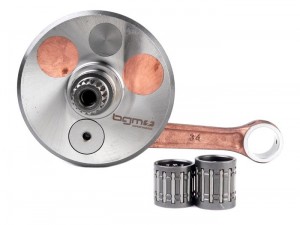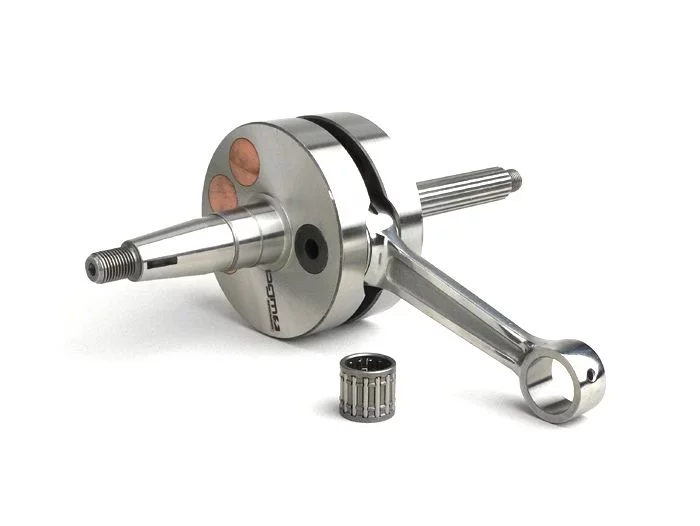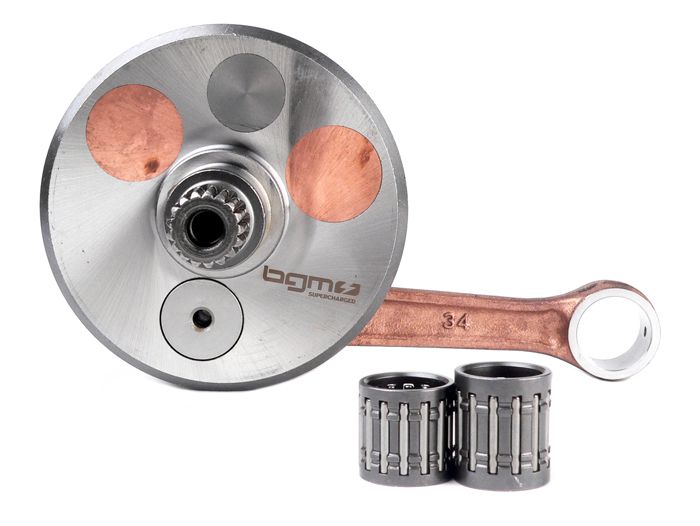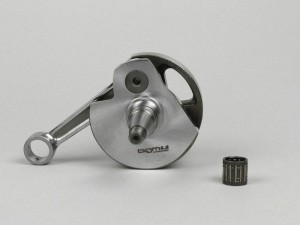bgm crankshafts for Vespa, Lambretta and Automatics
 Here's a little update on scooter crankshafts in general. As a rule, the shafts and other engine components are designed for very low power. The width of the crankshaft and thus the diameter of the crank webs are correspondingly. The crankcase surrounding the shaft is the limiting factor that determines the possible dimensions of a crankshaft. The overlap of the crank pin is thus given within a certain framework. Making the shaft wider in order to increase the coverage of the crank pin is only possible with a few engine concepts and there only to a very limited extent.
Here's a little update on scooter crankshafts in general. As a rule, the shafts and other engine components are designed for very low power. The width of the crankshaft and thus the diameter of the crank webs are correspondingly. The crankcase surrounding the shaft is the limiting factor that determines the possible dimensions of a crankshaft. The overlap of the crank pin is thus given within a certain framework. Making the shaft wider in order to increase the coverage of the crank pin is only possible with a few engine concepts and there only to a very limited extent.
Therefore, the maximum load capacity of the shafts is de facto given. Regardless of this theoretically quite low load limit, serious tuning of the motor often puts 200-700% more power into the case. The fact that the waves can withstand this load is due to several factors.
With some crankshaft types, for example the Lambretta GP series, it is possible to install a crank pin with a larger diameter than the standard. That's how they come BGM Lambretta crankshafts among other things with a 22mm instead of the standard Lambretta size of 20mm.
In the Vespa waves Unfortunately, this little trick is only possible to a limited extent. Nevertheless, thanks to the correct oversize of the crank pin and the correct pressing technique with the use of Loctite, we have managed to construct super durable shafts. These are manufactured exclusively for us by a renowned European crankshaft manufacturer.
The Vespa Smallframe Shafts are used in a number of ESC motors and are absolutely unbeatable in terms of price-performance ratio. They are available with a stroke of 51 mm and 54 mm as well as with the PK or the ETS cone. Both Smallframe For engines, a larger diameter of the crank web is fortunately possible. In terms of the radius, this results in a higher coverage and thus more security. In order to accommodate the shaft, the crankcase must be spindled accordingly. Fortunately, thanks to sufficient material, this is not a big problem.
The Vespa PX 200 shafts are the reference for all rotary vane motors, as they come with a perfect inlet time, a flow-optimized geometry of the inlet cheek and a very favorable balancing factor.
There are variants with 57 mm and 60 mm stroke. Both enable powerful and durable engines. The inlet angle is kept as long as possible but as short as necessary to prevent the blowback into the carburettor that is common with other manufacturers.
Another reference in the crankshaft sector are the bgm Evo Piaggio Maxi 2-T Waves.
They are used in all of our demonstrator engines. From the 38PS ZIP to our one-off two-cylinder which maltreats the crankshaft with over 50NM.
 These selected examples clearly show that a properly constructed shaft is durable. There can be room for improvement in terms of details and depending on the engine concept. Of course, this requires a minimum level of knowledge of the subject. TIG welded connecting rod journals, in which the entire crank webs discolour or massive material removal around the crankpin, are often causes of massive damage to the shaft and, as a result, to the surrounding components.
These selected examples clearly show that a properly constructed shaft is durable. There can be room for improvement in terms of details and depending on the engine concept. Of course, this requires a minimum level of knowledge of the subject. TIG welded connecting rod journals, in which the entire crank webs discolour or massive material removal around the crankpin, are often causes of massive damage to the shaft and, as a result, to the surrounding components.
Often, further processing is not necessary even for maximum performance results.
Rotary valve housing converted to a diaphragm inlet can bring almost 130HP to the rear wheel from 30ccm. And that with surprisingly small cross-sections between the housing and the shaft.








Leave a Reply
Want to join the discussion?Feel free to Contribute!